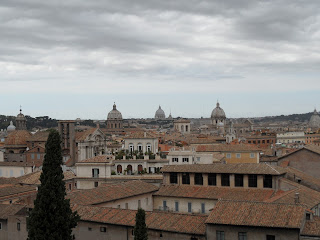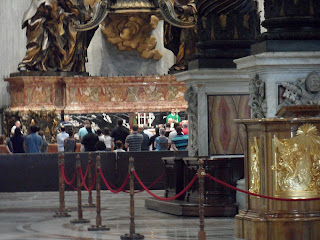Saturday September 1, 2012 – ROME, ITALY
 |
| This is not a sign that most people pay attention to. |
…but some of them are rather circuitous. If my dad hadn’t asked a conductor if we were
on the right train, I would be in Milan right now. Luckily, we were able to change trains after
one stop and get to the right city.
While the mishap with the trains kind of killed the morning,
my plan for the day was more or less unaffected.
Probably one of my favorite museums in the world, The
Capitoline Museum sits perched on Capitol Hill.
Its café on the second floor offers some of the best views of the
city.
Inside, the museum is partially
built around the ruins of a temple to Jupiter.
If you’re super cheap, you can actually head down to the basement, see
these ruins, and have an unparalleled view of The Forum. The museum even kindly provides signs that
tell you what you’re looking at in the forum, so you don’t even have to wait on
the massive lines and pay admission to see the site.
Upstairs, there’s an amazing collection of
busts of emperors and philosophers collected with other sculpture and painting. While I was there, the museum had a special
exhibition on called Lux in Arcana marking the 400th anniversary of
the foundation of the Vatican secret archives.
They actually had selected pieces from the secret archives on
display. They had records of votes from
conclave, a letter from Hirohito congratulating Pope Pius XII on becoming pope,
the last letter from Mary Queen of Scots to Pope Sixtus V, the actual document
excommunicating Martin Luther, the transcript from the trial of Galileo and of
the Knights Templar, and letters from Abraham Lincoln and Jefferson Davis to
Pope Pius IX along with a ton of other stuff.
There was so much church history in those rooms and that’s just the
stuff they’re letting the public see.
In a similar vein, I crossed the border from Italy to The
Holy See to see St. Peter’s Basilica.
Midafternoon is absolutely the time to visit; I have never seen the
lines so short. Incidentally, I was
there while mass was on, so I didn’t get down into the grotto (the entrance is
way up in the front), but the part that wasn’t closed off to tourists still had
plenty to see. I have apparently been
obsessed with the Pieta since I was 5 (that’s the story my mother tells, so I
don’t know how seriously to take it), but I do know it’s one of my favorite
parts of the Basilica. No matter how
many cathedrals I go to, St. Peter’s Basilica never gets old. Bernini, without a doubt my favorite
sculptor, designed the façade, colonnade, and baldachin at St. Peters, so
that’s always a highlight for me.
Finally (because it’s open until 7:30), I walked to the
Pantheon. This is my other favorite
building in Rome, but that has a lot to do with the fact that I did a paper in
sixth grade on roman engineering and spent a lot of time talking about the dome
and oculus of the Pantheon. The Pantheon
is kind of plain looking now because it has suffered some heavy looting over
the years. Hadrian had it built to honor
all of the gods and it is a marvel of roman architecture. The brick of the walls is arranged in arches
to distribute the weight of the concrete roof.
The roof is freaking concrete, but has square cutouts to help reduce the
weight. The oculus was constructed so as
to use the tension around the opening to help keep the roof up. Not bad for a civilization that approximated
pi to 4. It was turned into a church by
the Christian rulers and seems to still hold services. It also houses the tombs of the first two
kings of unified Italy and Raphael. The
latter’s tomb is inscribed with "Ille hic est Raffael, timuit quo sospite
vinci, rerum magna parens et moriente mori," meaning: "Here lies that
Raphael by whom Nature feared to be conquered while he lived, and when he was
dying, feared herself to die". Or
something like that. My Latin’s a little
rusty.
This morning, before heading to the airport, I stopped by
the Borghese Gallery. There are some
lovely painting upstairs, but I really go for the sculpture on the ground
floor. Among others (the Borgheses were
ridiculously wealthy), the gallery features Bernini’s Apollo and Daphne, David,
Aeneas and Anchises, and The Rape of Persephone. Aeneas
and Anchises depicts Aeneas, his father, and his son fleeing the burning
Troy. His father holds the household
gods and his son holds the eternal flame; Aeneas is the founder of Latium,
later Italy, and the father of the Romans.
The Rape of Persephone is
terrifyingly detailed. Persephone’s skin
actually dimples where Hades grabs her and you can see the tracks of two tears
on her face. David, borrowing Bernini’s own face, shows David about to loose a
stone from his sling; this was the first sculpture of David to show him in
motion. Finally, Daphne and Apollo (my favorite), depicts the most dramatic and
dynamic moment in one of Ovid's stories in his Metamorphoses. In the story, Apollo, the god of light, scolded
Eros, the god of love, for playing with adult weapons. In retribution, Eros
wounded Apollo with a golden arrow that induced him to fall madly in love at
the sight of Daphne, a water nymph sworn to perpetual virginity, who, in
addition, had been struck by Eros with a lead arrow which caused her to harshly
spurn Apollo's advances. The sculpture depicts the moment when Apollo finally
captures Daphne, yet she has implored her father, the river god, to destroy her
beauty and repel Apollo's advances by transforming her into a laurel tree. This particular part of the story features
one of my favorite lines in classical literature, roughly translated: “If you
will not be my wife, you will be my tree!”
Firstly, great story. Secondly,
hilariously bad translation forced on our class by my evil Latin III Honors teacher. The Borghese Gallery is one of the best small
museums, and I mean small. It’s 100%
worth it to get there at 9AM when it opens because it gets crowded quickly.
That’s the trip. I’ll
be back home in New York soon and I’ll throw these up on the web along with
pictures.






















































